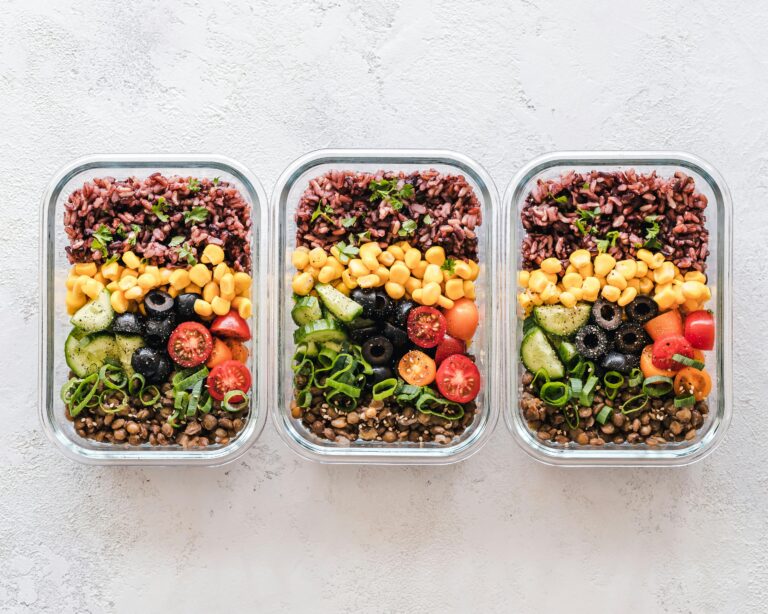The Blood Type Diet: Personalized Nutrition Strategies for Weight Loss Success

Table of Contents:
Overview
In the quest for optimal health and weight loss, the Blood Type Diet has emerged as a personalized nutrition strategy worth exploring. The concept is simple yet intriguing: tailoring dietary choices based on one’s blood type to unlock weight loss success and overall well-being.
The theory underlying the Blood Type Diet revolves around the idea that each blood type (A, B, AB, and O) possesses unique genetic characteristics that influence how the body processes and reacts to various foods. By aligning dietary choices with these genetic predispositions, proponents of the diet claim that individuals can experience improvements in energy levels, digestion, and weight management.
Whether you’re intrigued by the science behind the Blood Type Diet or simply seeking new approaches to enhance your well-being, this article aims to provide valuable information and practical advice to support your health and fitness goals.
Understanding the Blood Type Diet
Understanding the Blood Type Diet is like unlocking a personalized nutrition code tailored to your unique biological makeup. It categorizes individuals into four blood types—Type O, Type A, Type B, and Type AB—and prescribes specific dietary recommendations for each type.
The genesis of the Blood Type Diet stems from a blend of disciplines, including genetics, anthropology, and immunology. Dr. Peter D’Adamo, the proponent of this diet, proposed that each blood type evolved at different junctures in human history, influencing the dietary needs and tolerances of individuals.
For instance, Type O is often referred to as the “hunter-gatherer” blood type, emphasizing a diet rich in lean meats, fish, and vegetables. Conversely, Type A is considered the “agrarian” blood type, advocating for a primarily plant-based diet with limited animal products.
Type B blood individuals are encouraged to consume a varied diet, including dairy, meat, grains, and produce, reflecting their purported origins as nomadic herders. Lastly, Type AB, the most recent blood type to evolve, combines some elements of Type A and Type B diets, focusing on a balanced intake of fruits, vegetables, grains, and proteins.
By aligning dietary choices with one’s blood type, proponents of the Blood Type Diet believe it can optimize digestion, enhance energy levels, and facilitate weight loss. However, it’s essential to approach this concept with a critical mindset and consult with healthcare professionals before making significant dietary changes.
Type O Blood Diet
The Type O diet revolves around high-protein foods, with a spotlight on lean meats, fish, vegetables, and fruits. These choices are believed to complement the digestive system and metabolism of Type O individuals, promoting weight loss and overall well-being.
When it comes to foods to avoid, Type O individuals are advised to steer clear of dairy, wheat, and legumes. These foods are thought to be less compatible with the Type O digestive system and may potentially lead to digestive issues or hinder weight loss progress.
For those embarking on the Type O Blood Diet journey, meal planning plays a pivotal role. Incorporating plenty of Type O-friendly foods into your meals can set the stage for weight loss success. Think hearty salads with grilled chicken, stir-fries loaded with colorful veggies and lean beef, or seafood-based dishes paired with steamed greens.
By crafting meals that align with the Type O Blood Diet guidelines, individuals can optimize their nutrition while working towards their weight loss goals. However, as with any dietary approach, it’s essential to listen to your body and make adjustments as needed. Consulting with a healthcare professional or registered dietitian can provide personalized guidance and support along the way.
Type A Blood Diet
The Type A dietary approach places a strong emphasis on plant-based foods, including fruits, vegetables, whole grains, and legumes. These nutrient-dense options are believed to complement the Type A digestive system and promote weight loss and overall health.
When it comes to the Type A Blood Diet, meat and dairy products are typically limited or avoided altogether. These foods are thought to be less conducive to the Type A blood type and may potentially lead to digestive discomfort or hinder weight loss efforts.
For those following the Type A Blood Diet, there are plenty of delicious meal ideas and recipes to explore. Consider starting your day with a hearty bowl of oatmeal topped with fresh berries, enjoying a colorful salad with mixed greens, beans, and avocado for lunch, and savoring a vegetable stir-fry with tofu for dinner.
By incorporating a variety of plant-based foods into your meals and snacks, individuals with Type A blood can optimize their nutrition while working towards their weight loss goals. However, it’s important to listen to your body and make adjustments as needed, as everyone’s dietary needs and preferences are unique. Consulting with a healthcare professional or registered dietitian can provide personalized guidance and support on your journey to success.
Type B Blood Diet
Unlike some other blood types, the Type B diet offers a wide range of food options, including meats, dairy products, grains, and vegetables. The key to success with this diet lies in achieving balance and moderation, focusing on whole, natural foods while avoiding processed items.
Individuals following the Type B Blood Diet are encouraged to prioritize whole foods and steer clear of highly processed options. This means opting for lean proteins like poultry, fish, and eggs, along with plenty of fruits and vegetables. Incorporating whole grains such as quinoa, brown rice, and barley can provide sustained energy and support weight loss efforts.
When planning meals and snacks on the Type B Blood Diet, aim for a balance of macronutrients and flavors. Including a source of protein, healthy fats, and fiber-rich carbohydrates in each meal can help keep you satisfied and energized throughout the day. Snacking on nutrient-dense options like nuts, seeds, or Greek yogurt can also help curb cravings and prevent overeating.
It’s important to approach the Type B Blood Diet with flexibility and mindfulness. While certain foods may be recommended or discouraged based on blood type, individual preferences and tolerances should also be taken into account. Experimenting with different recipes and food combinations can help you find what works best for your body and supports your weight loss goals. As always, consulting with a healthcare professional or registered dietitian can provide personalized guidance and support along your journey.
Type AB Blood Diet
The Type AB Blood Diet blends elements from both the Type A and Type B diets. Individuals with Type AB blood have unique dietary recommendations that include a diverse array of foods, spanning from lean proteins and dairy to grains, fruits, and vegetables. This flexibility allows for a varied and balanced approach to nutrition while still aligning with the Type AB blood type guidelines.
Incorporating lean proteins like fish, tofu, and poultry can provide essential nutrients while supporting weight loss efforts for individuals with Type AB blood. Similarly, including dairy products such as yogurt or cheese can contribute to calcium intake and overall dietary balance. Whole grains like quinoa and oats can serve as a source of sustained energy and fiber, promoting feelings of fullness and aiding in weight management.
When planning meals on the Type AB Blood Diet, aim for a colorful and diverse plate filled with a variety of fruits and vegetables. These nutrient-rich foods not only support overall health but also contribute to weight loss goals by providing essential vitamins, minerals, and antioxidants. Experimenting with different cooking methods and flavor combinations can help keep meals exciting and satisfying.
As with any dietary approach, it’s essential to listen to your body’s cues and adjust your food choices accordingly. Pay attention to how different foods make you feel and prioritize those that leave you feeling energized and satisfied. Consulting with a healthcare professional or registered dietitian can also provide personalized guidance and support to help you navigate the Type AB Blood Diet and achieve your weight loss goals.
Evidence and Criticisms
While some proponents tout its effectiveness for weight loss and overall health, the scientific evidence supporting these claims is mixed. Some studies suggest potential benefits, such as improved metabolic markers and weight loss outcomes, particularly for certain blood types. However, the overall body of research is limited, and more rigorous studies are needed to validate these findings.
On the flip side, the Blood Type Diet has faced its fair share of criticisms and controversies. One major concern is the lack of scientific consensus on its validity and efficacy. Critics argue that the diet’s recommendations are not based on solid scientific evidence and may promote restrictive eating patterns that could lead to nutritional deficiencies or disordered eating behaviors.
As with any dietary approach, it’s crucial to approach the Blood Type Diet with caution and skepticism. While it may hold promise for some individuals, it’s not a one-size-fits-all solution, and its effectiveness may vary from person to person. Moreover, relying solely on blood type as a determinant for dietary choices overlooks other important factors such as individual preferences, cultural influences, and overall lifestyle habits.
Before embarking on the Blood Type Diet or any significant dietary changes, it’s essential to consult with a healthcare professional or registered dietitian. They can provide personalized guidance and support, help you navigate the complexities of the diet, and ensure that your nutritional needs are being met appropriately. Ultimately, the key to successful weight loss and overall health lies in adopting a balanced and sustainable approach to eating that works best for you.
Conclusion
In wrapping up our discussion on the Blood Type Diet, let’s recap the key takeaways for weight loss success. This diet emphasizes personalized nutrition strategies tailored to individual blood types, with specific dietary recommendations for Types O, A, B, and AB. By aligning your food choices with your blood type, proponents suggest that you can optimize your health and achieve your weight loss goals more effectively.
However, it’s essential to approach the Blood Type Diet with a critical eye. While some evidence supports its potential benefits, the diet also faces criticisms and controversies, including a lack of scientific consensus and the potential for restrictive eating patterns. Therefore, it’s crucial to weigh the pros and cons carefully and to consider consulting with a healthcare professional before diving in.
Ultimately, the decision to try the Blood Type Diet or any dietary approach should be guided by your individual health goals, preferences, and needs. While personalized nutrition strategies based on blood type may offer some benefits for certain individuals, they’re not a guaranteed solution for everyone. It’s essential to listen to your body, pay attention to how different foods make you feel, and make choices that align with your overall well-being.
In conclusion, while the Blood Type Diet offers intriguing possibilities for personalized nutrition and weight loss, it’s not without its caveats. As you explore this dietary approach, keep in mind the importance of balance, moderation, and individualized care. And remember, when in doubt, it’s always wise to seek guidance from a qualified healthcare professional who can help you navigate the complexities of dietary choices and support you on your journey to better health.






